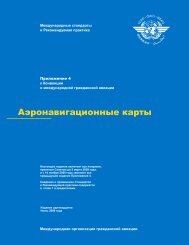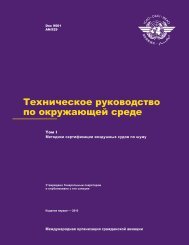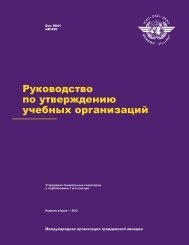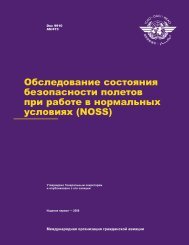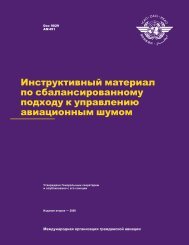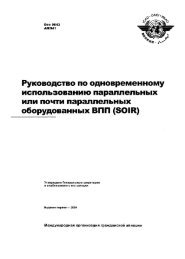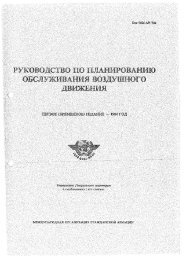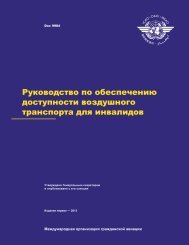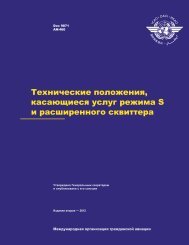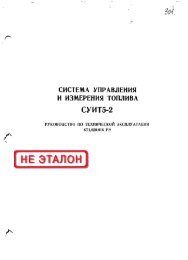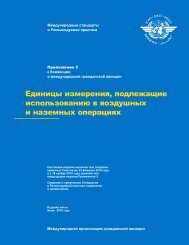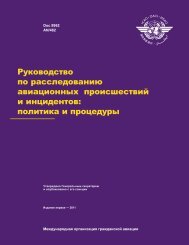Doc 9824 - СеÑÑиÑикаÑÑ Ñипа (ÐÐÐ)
Doc 9824 - СеÑÑиÑикаÑÑ Ñипа (ÐÐÐ)
Doc 9824 - СеÑÑиÑикаÑÑ Ñипа (ÐÐÐ)
Create successful ePaper yourself
Turn your PDF publications into a flip-book with our unique Google optimized e-Paper software.
D02307MILLET ET AL.: ISOPRENE EMISSIONS FROM THE OMI SENSORD02307Inventory System (BEIS) models for the United States [Pierceet al., 1998], by including updated information on baseemissions and environmental dependences. Emissions arecomputed as a function of solar irradiance, temperature, leafage and vegetation-specific emission factors (EFs) for sixplant functional types (PFTs): broadleaf trees, shrubs, fineleafevergreen trees, fineleaf deciduous trees, crops, and grass +other. Isoprene emission E for a given area (e.g., model gridsquare) is given byE ¼ g X6i¼1e i c i ;where the sum is over all PFTs with fractional arealcoverage c i and canopy emission factor e i under standardconditions of light, temperature, leaf area index (LAI) andleaf age; and g is an activity factor accounting for emissionchanges due to local variability in those parameters(equation (2)). The EFs for a given PFT vary geographicallyaccording to the local taxonomic makeup of the PFT.Species-level PFT composition is obtained from quantitativeground surveys where available, and estimated from theterrestrial ecoregion database developed by Olson et al.[2001] elsewhere. The overall activity factor g is theproduct of a set of non-dimensional activity factors eachequal to one at standard conditionsg ¼ g T g PAR g LAI g age :ð1Þð2Þ[20] The temperature activity factor g T is a function of thecurrent temperature and the mean local temperature over thepast 15 days, while the light activity factor g PAR is calculatedas an integral over the canopy depth to account forlight attenuation and the effect of direct and diffuse light onsunlit and shaded leaves [Guenther et al., 1999]. Theactivity factors g LAI and g age account for emission changesdue to seasonal variation in local leaf area index and leafage [Guenther et al., 2006]. The MEGAN algorithm toaccount for isoprene emission variations driven by soilmoisture was not implemented for this study. The soilmoisture option results in decreased isoprene emissionsduring drought and is not likely to have a significant impactin areas of major isoprene emission in North America.[21] We drive MEGAN with assimilated meteorology(surface air temperature, direct and diffuse photosyntheticallyactive radiation) at 2° 2.5° horizontal resolution and3 hour temporal resolution from the NASA Goddard EarthObserving System (GEOS-4), using monthly LAI derivedfrom the Advanced Very High Resolution Radiometer(AVHRR) Pathfinder Normalized Difference VegetationIndex data set [Myneni et al., 1997].[22] The isoprene emission calculated with MEGANdepends on the choice of vegetation database used to assignfractional coverage for each PFT within a grid square. Herewe use two different databases to examine the sensitivity tothat choice. The first, MEGAN Driving Variables Databaseversion 2.0 (MDVD2), is the standard case for the analysisdescribed by Guenther et al. [2006]. The MDVD2 PFTfractions integrate the percentage vegetation coverage andtype (woody vs. herbaceous) at 500 m resolution fromMODIS [Hansen et al., 2003] with leaf longevity (evergreenvs. deciduous) and leaf type (broadleaf versus needleleaf)from the 1 km AVHRR-derived University ofMaryland tree cover data set [DeFries et al., 2000]. Relativeabundance of the non-tree PFTs is determined from groundsurvey information where available and the Olson et al.[2001] ecoregion database elsewhere. The AVHRR-basedbroadleaf and needleleaf PFT fractions in the United Statesare adjusted using ground survey information compiled byKinnee et al. [1997]. The second vegetation database isfrom the Community Land Model (CLM) [Oleson et al.,2004]. CLM obtains percentage tree cover, leaf type, andleaf longevity from AVHRR [DeFries et al., 2000], andunderstory and herbaceous PFT distributions from the IGBPDISCover land cover data set [Loveland et al., 2000] (alsoderived from AVHRR). We lump the 16 CLM vegetationtypes into categories corresponding to the six MEGANPFTs.[23] Figure 5 shows the percent distribution of the 6 PFTsaccording to the MDVD2 and CLM vegetation databases,along with the associated isoprene EFs. Broadleaf trees arethe largest isoprene emitters and are concentrated in theeastern United States. Shrubs also have a high EF and aremore abundant in the arid West. However, because of theirlower leaf area, the resulting isoprene emissions are lowerthan those from broadleaf trees. The other four PFTs areonly minor isoprene sources according to MEGAN.[24] There are significant differences between MDVD2and CLM in the estimated distributions of the PFTs.MDVD2 has more broadleaf trees in the Deep South andalong the Southern to Mid-Atlantic coast, where CLMassigns more of the vegetation coverage to fineleaf evergreentrees and grasses. CLM has more broadleaf trees inthe U.S. Northeast and Midwest, where MDVD2 tends toput more crops and shrubs. Both MDVD2 and CLM havethe highest density of shrubs in the West, but the differenceis more dramatic in CLM, with no shrubs in the East.[25] Figure 6 shows MEGAN isoprene emissions computedusing MDVD2 and CLM. Guenther et al. [2006]compared global annual average isoprene emissions usingthese two databases and found CLM emissions to be 7%lower. Here, focusing on North America for June-August2006, we find that both MDVD2 and CLM-driven emissionsare highest in the Southeast and Mid-Atlantic regions,but there are large differences. The total North Americanemission for the domain of Figure 6 is 18% higher inMDVD2 (14.6 TgC) than in CLM (12.2 TgC). Regionaldifferences often exceed a factor of 2. The Southeastemission maximum in CLM is focused in the Ozark Plateau(Arkansas/Missouri) and the Upper South, while withMDVD2 the greater regional abundance of broadleaf treesleads to elevated emissions extending through the DeepSouth to the Gulf coast. CLM emissions are higher thanMDVD2 in the Upper Midwest, again because of higherestimated broadleaf tree coverage. Below we will useHCHO column measurements from OMI to test thesedifferent results.3.2. GEOS-Chem Chemical Transport Model[26] We use the GEOS-Chem global 3D CTM [Bey et al.,2001; Millet et al., 2006; Palmer et al., 2006] to simulatethe HCHO vertical distribution needed for the AMF calculationin the OMI retrieval, and to quantify the relationship6of18



